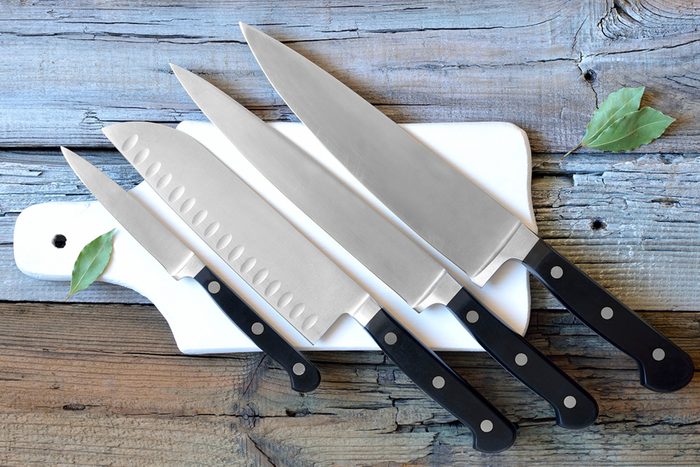Here’s the Safest Way to Get Rid of Your Old Kitchen Knives
Updated: Oct. 26, 2018

Wondering how to dispose of kitchen knives? Don't throw 'em straight in the trash! Here's how to handle your sharp situation.
Anyone who’s spent a lot of money on kitchen knives knows how important it is to maintain them. It’s definitely not economical to buy a new knife every year when it gets dull! Almost any knife can be revived (no matter how dull it is), but it’s much harder to do when your blade is broken or has large chips. Some pros can hammer out the chips, but if your knife is missing a large chunk, it might be destined for the trash.
If you don’t know how to dispose of kitchen knives, read on to find out!
How to Dispose of Kitchen Knives
Keep in mind that knives—even dull ones—are sharp objects that can harm sanitation workers, so it’s not enough to simply toss them. Before we tell you how to safely throw your knife away, consider an alternative:
Donate your knives
Maybe your knife isn’t damaged and you’re just in the market for a new one. Or, perhaps you’re not willing to fix the chip, but someone who has the means may be able to repair it. The point is, even if it’s unusable by your standards, someone else may be glad to have your old knife. Consider donating it to a friend setting up his or her first kitchen, or look to charitable organizations like the local soup kitchen, Goodwill or the Salvation Army.
Pro Tip: Before you go through the trouble of traveling to donate the knife, call to make sure they’ll accept this type of donation.
Recycle old knives
Many metro areas have a scrap metal recycler, so find out if there’s one near you. You’ll need to know the type of metal used for your knife (ceramic, stainless steel, carbon steel, aluminum, titanium, etc.). If you don’t, start by doing a magnet test: Hold a magnet up to the blade. If it’s attracted, the blade is made from a ferrous material; if not, it’s non-ferrous. Your scrap metal recycler will be able to help you from there.
Here’s a look at three top knife replacements: ceramic, stainless steel and carbon steel.
If all else fails, your knives are destined for the trash
If none of the above are options for you, it might be time to trash your old knives. But, you shouldn’t simply toss them into the can—that’s dangerous. Start by wrapping your knives in several layers of newspaper. Then, find a piece of cardboard that’s more than twice the depth of the blade. Fold the cardboard in half and place the back of the blade against the folded side. Secure the cardboard to the knife using heavy-duty tape. Then, place the wrapped knife in a box and seal the lid with tape.
Ready for a replacement? Here are the best kitchen knives every cook should have.




















